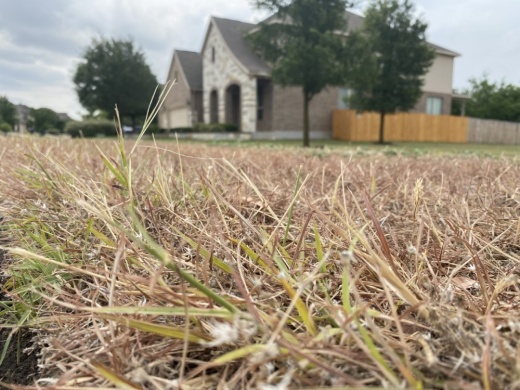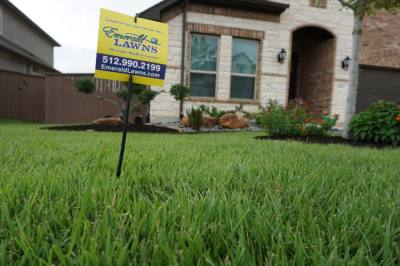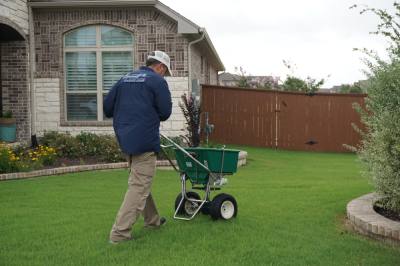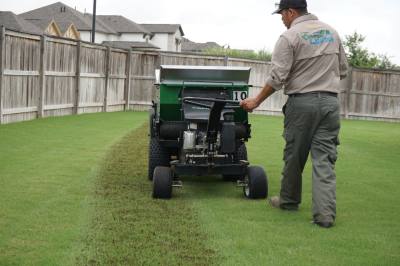During a summer of unprecedented high temperatures and drought restrictions implemented across Central Texas, giving your lawn the care it needs is more crucial than ever—and catching lawn issues early can help cut down recovery time and limit damage.
While winter dormancy is a normal occurrence, sparse rainfall and skyrocketing temperatures in the region have increased the risk for summer drought-induced dormancy, which causes lawns to stop growing and turn a golden-brown color until water becomes available. To help lawn owners keep their soil and turf in proper health during these unfavorable conditions, Emerald Lawns is sharing expertise on how to best prep lawns for success.
1. Prioritize soil health and recovery
Maintaining healthy soil is the only way to achieve a lush lawn, and Central Texas soil requires annual restoration. Lawns are like sponges, so even the best watering practices will not help if the soil is tense and dry.
Hydrophobic soil is common in the region, which occurs when a waxy coating develops on the soil’s surface to protect itself from heat and retain moisture. Though it is a natural defense mechanism, hydrophobic soil repels water instead of absorbing it. To combat this, Emerald Lawns specialists apply moisture management technology called Hydretain to reduce moisture evaporation and transform humidity in the air into plant-usable water droplets to enable roots to absorb up to 50% more water.
“[Hydretain] has little polymers that are like little sponges trying to adhere to the root and store those water droplets,” said Walt Petticrew, Chief Marketing Officer at Emerald Lawns. “It has a dispersion piece so that it goes throughout the root system. It’s bringing in the humidity, reducing water loss to evaporation and doing what it can with the littlest bit of water.”
Emerald Lawns also locally sources and audits its lawn topdressing, which is made up of 50% cotton burr, 25% pine shavings, 20% pine saw dust and 5% rice hulls. The concentrated combination of organic matter and nutrients triggers the microbial activity that roots need. Proven to increase root density and grass growth, Emerald Lawns technicians apply topdressing from September through December and from January to May.
2. Mow in the morning or evening
Emerald Lawns experts recommend mowing lawns in the morning or the evening, as cutting grass during the heat of the day adds another stress at a time when it is already tired and wilted.
“When your body shuts down, your extremities get cold because your body is trying to keep your heart warm. Your yard works very much the same way, where it’s going to be shutting down everything,” Petticrew said. “If you cut in the heat of the day, you’ve just added another stressor when it’s trying to conserve.”
Keeping mower blades sharp and clean is also vital during drought conditions, because sharp blades promote faster healing and dirty blades can spread diseases like Helminthosporium. If part of a lawn is infected, clean mower blades with alcohol before mowing the rest of the lawn.
Technicians at Emerald Lawns recommend that Bermuda grass of a dwarf variety be cut one inch weekly, and two inches for other types. Augustine grass should be cut three to four inches, and course-bladed Zoysia requires a two to three inch cut while fine-bladed Zoysia needs a one to two inch cut. Mowing weekly prevents thatch layers from developing between your soil and grass.
3. Water your lawn the right way
As many drought restrictions put limits on how and when lawns can be watered, an irrigation system check is key to making sure lawns are absorbing as much water as possible during a cycle. Emerald Lawns irrigators can reassess controller settings with the correct yard slope and soil compaction and depth in mind, and many city water districts offer rebates on irrigation system inspections.
Central Texas homeowners should water in the morning, as watering in the evening can promote periods of prolonged wetness and promote conditions for diseases like Helminthosporium.
In the dry summer months, Emerald Lawns utilizes Hydretain to improve water dispersion throughout the yard, allowing small amounts of water to make a bigger impact.
4. See what Emerald Lawns can do to help
Looking ahead to September and October, Emerald Lawns technicians will begin to prepare lawns for winter’s cooler temperatures with lawn fertilization services. The goal is to help with stress restoration above the surface and proactively reduce weeds beneath the surface. Microorganisms increase the nutrient-holding capacity of roots, and sulfur controls excessive pH levels.
For Bermuda lawns, technicians will apply a low dose of nitrogen to rejuvenate areas impacted by summer stressors such as drought, disease and pests—and their six-month weed control barrier stops weeds before they can start growing. St. Augustine and Zoysia lawns will receive a large dose of potassium to help the plant take in more water and nutrients, and prodiamine, a light weed control, to address weeds without negatively impacting the root system.
Different from most corporate lawn care companies, Emerald Lawns technicians assess each lawn to determine a plan of action that will ensure the best results. They proudly serve the Austin, San Antonino and Temple areas, focusing on consistent results, responsive customer service and personalized lawn care.
If your lawn needs attention, visit https://emeraldlawns.com/ to learn more or get an instant quote and free evaluation by calling 512-990–2199. The Emerald Lawns website is a one-stop resource for everything you need to know about maintaining a healthy lawn.
The above story was produced by Community Impact Newspaper's Storytelling team with information solely provided by the local business as part of its sponsored content purchase through our advertising team. Our integrity promise to our readers is to clearly identify all CI Storytelling posts so they are separate from the content decided upon, researched and written by our journalism department.
Select your community
Support Us
News
- Austin Metro
-
Houston Metro
- Houston Metro Home
- Bay Area
- Bellaire | Meyerland | West University
- Conroe | Montgomery
- Cy-Fair | Jersey Village
- Cypress
- Heights | River Oaks | Montrose
- Katy | Fulshear
- Lake Houston | Humble | Kingwood
- New Caney | Porter
- Pearland | Friendswood | Manvel
- Spring | Klein
- Sugar Land | Missouri City
- The Woodlands
- Tomball | Magnolia
- Dallas | Fort Worth Metro
- San Antonio Metro










